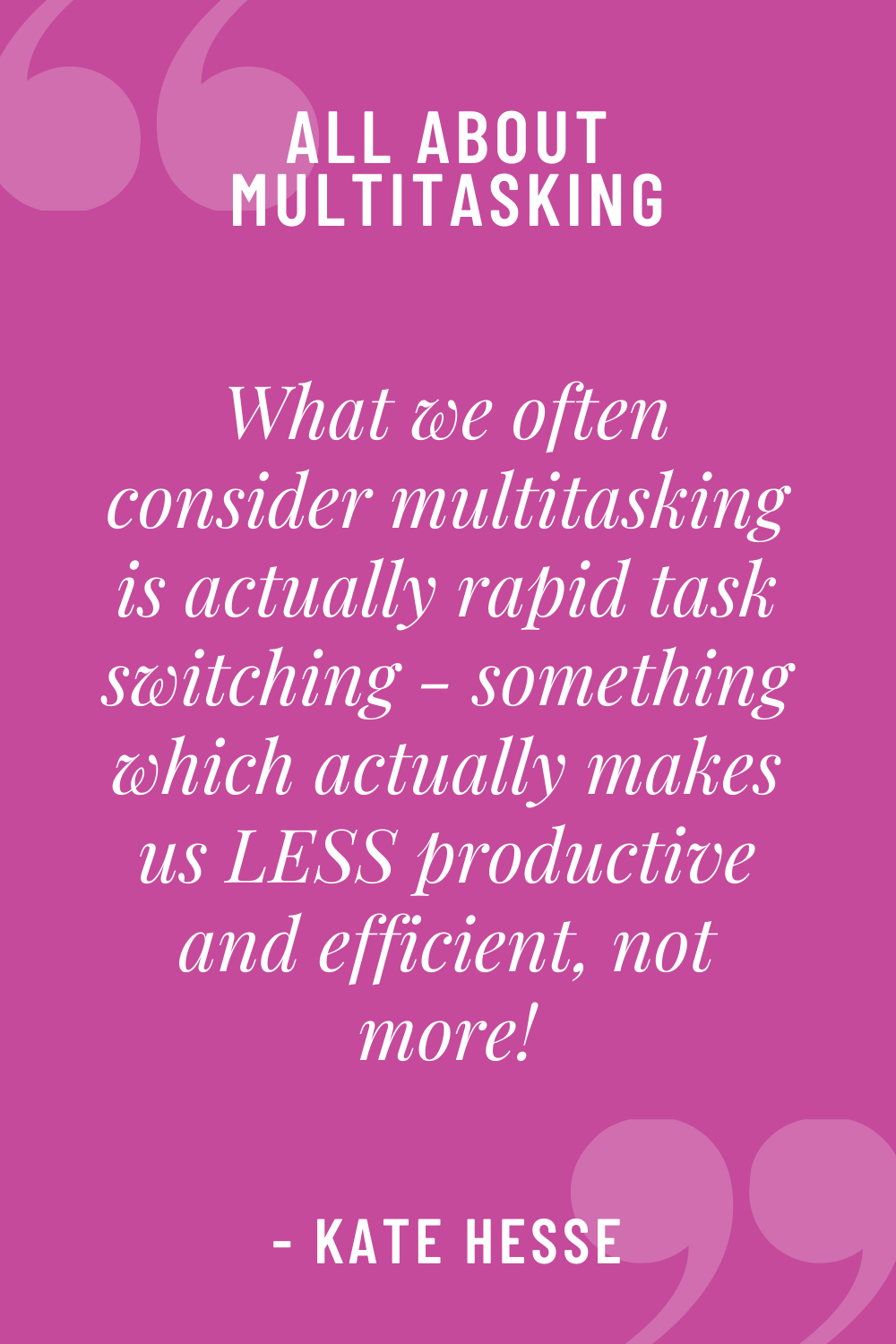
Spoiler alert, multitasking as we frequently think of it, isn’t actually a real thing! It just isn’t how our brains work!
You can learn more about the issues with multi-tasking and how to start breaking the habit here.
But if your goal is to bring more productivity into your life, I’ve got you covered! Check out the links mentioned in the episode (and below) for more information!
What we call multitasking, isn’t actually multitasking!
This probably isn’t the answer you came here to read, but the truth is that what we often consider multitasking is actually rapid task switching. True multitasking requires that one task be nearly autonomic, something so well learned that your body does it without engagement from your mind.
True multitasking includes things like being able to walk and talk at the same time. Walking is the body action, talking is the mind action. Or eat while reading. Chewing and swallowing is a body action, reading a mind action.
What we often call multitasking is rapid task switching. Things like watching television while scrolling social media. What you’re really doing is paying attention to the tv for a bit of time, and then switching your focus to your social media feed, and back and forth.
 Why rapid task switching makes you LESS productive, not MORE!
Why rapid task switching makes you LESS productive, not MORE!
While some people may be better at rapid task switching than others, here’s why it’s actually making you less productive, not more!
Imagine you’re driving a car. Every time you switch from one task to another, it’s the equivalent of slamming on the brakes and going from forward to reverse, or vice versa, and then getting back up to speed. It takes time to slow the car down, shift directions, and then speed back up. While that can take as little as a few tenths of a second, the more complex the task the longer it takes.
Now imagine you switch your focus once every minute and odds are you’re actually switching more often than that. That means you would shift your focus 60 times an hour. We’re starting to look at the time you’ve lost in minutes, not seconds. Multiply that out by a day, a week, a year. Add in more time lost if you’re working on more complex tasks that require more time to slow down, change directions, and speed back up. And suddenly you start to understand why some experts cite 40% as the amount of productive time people lose in multi-tasking.[1]
Learn more about the issues with multitasking and how to start breaking yourself of the habit.
You don’t have to multitask to be efficient!
There are ways to increase your productivity that don’t require cloning yourself. And by the way, I totally understand that feeling, there were many years when I wished I could make 10 copies of myself to get everything on my to-do list done.
So, let’s get started with ways you can increase your productivity. And the first one is to stop multitasking! This should make sense by now! Start blocking out enough time on your schedule to focus on one thing at a time. Learn more about organizing your schedule and to-do list in a way that works for you.
Next, review your to-do list, remove anything that isn’t in alignment with your unique priorities and values. Then identify your distraction activities, and begin to replace them with productive procrastination.
You can learn more about these productivity techniques in my free Productivity Workshop.
Nourish yourself so you can take care of everything on your to-do list!
Finally, make sure you have a consistent, sufficient, and sustainable self-care routine. Self-care is how we refill our mental, emotional, and physical energy reserves.
Think about this as the difference between driving around in a new Tesla or a 1970’s Pinto. When you have enough self-care in your life, you operate at peak efficiency. When your energy reserves are depleted, it takes more time and energy to complete anything.
You can learn more about self-care and how to create a self-care routine that works for you and your life by downloading my free Self-Care Toolkit.
While these are the basics, there’s some big work that goes into implementing some of these tools and techniques. Consider working with a coach to make sure you have the support you need to stop feeling overwhelmed and start feeling like you’re in the driver’s seat in your life!
You can learn more about my coaching program by signing up for a no-cost Discovery Session.
I’m sending you a great big hug – you’ve got this!
If you enjoyed this episode of Solicited Advice, check out other episodes, and while you’re there, make sure you subscribe to my YouTube Channel so you don’t miss out on future episodes released each Monday & Thursday!
Related
One thought on “All about multitasking when you want to clone yourself!”
Leave a Reply Cancel reply
This site uses Akismet to reduce spam. Learn how your comment data is processed.
[…] most circumstances, I’m not a fan of multi-tasking. What we often refer to as multi-tasking is simply rapid task switching. It results in doing […]